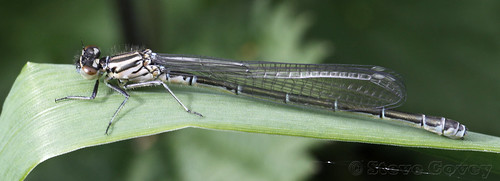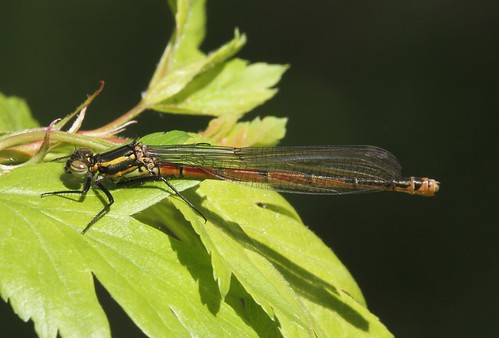First of all - apologies [yet again ;o/] for a lack of posts after May last year and for failing to add images to the blog some of you so kindly sent me. Juggling getting out during the all too infrequent fine spells with processing data for the Atlas Project are partially to blame..I'll endeavour to do better this year!
Again, despite the weather, we collectively saw 28 species in the county! As follows:
Beautiful Demoiselle,
Banded Demoiselle,
Emerald Damselfly,
Large Red Damselfly,
Small Red Damselfly,
White-legged Damselfly,
Azure Damselfly,
Common Blue Damselfly,
Blue-tailed Damselfly,
Scarce Blue-tailed Damselfly,
Red-eyed Damselfly,
Hairy Dragonfly,
Common Hawker,
Migrant Hawker,
Southern Hawker,
Brown Hawker,
Emperor Dragonfly,
Golden-ringed Dragonfly,
Downy Emerald,
Four-spotted Chaser,
Broad-bodied Chaser,
Scarce Chaser,
Black-tailed Skimmer,
Keeled Skimmer,
Black Darter,
Common Darter,
Ruddy Darter and
Red-veined Darter
A pretty good tally I think you'll agree.
Despite this year being the second wettest on record I am pleased to be able to report some successes!
During the all too brief days of bright, calm, sunny weather I, and other Wiltshire observers, managed to visit all the remaining hectads in the county that had had no or few records between 2000 and 2011. The end result is that all bar one of our 10k squares now have had some species recorded in them. That remaining one is only a partial Wiltshire square and is mostly chalk downland with the only water being the upper reaches of a winterbourne that is usually dry during the spring and summer. So, unless a garden pond in one of the scattered villages turns up trumps, it will remain a blank. But I think this is a great result for a county that is often perceived as being predominantly ‘dry’ chalk grassland!
Also completed was all the fieldwork for the Cotswold Dragonfly Atlas Project. Gareth Harris now has the mammoth task of collating all this information and producing the eagerly awaited publication!
Of course, we can’t rest on our laurels, as although the national atlas fieldwork is now complete, surveying needs to continue towards a proposed Wiltshire Atlas. For this the recording needs to be at a finer resolution – at least to tetrad level.....no rest for the wicked!!
Moving on to the species themselves; Again, despite the general weather conditions, several species had a very good year. Perhaps it was a case of poor weather for the recorder but not for the recorded?
Downy Emerald (Cordulia aenea) had an exceptional season within the Cotswold Water Park [CWP], with large numbers of emergences and exuviae noted at existing and new locations. I found an exuvia on the early date of 30th April at Lower Moor Farm. This was followed up by observations of emergence in early May; Terry Dabner, Rosie Ray, Chris Beard and I were fortunate enough to see and photograph these amazing transformations that make our beloved dragonflies so unique! (Images l to r: S. Covey; T. Dabner; C. Beard).

On 27th May Rosie Ray found a male Hairy Hawker (Brachytron pratense) at one of the lakes in the CWP. Then she found another the following day at a different lake some distance from the first which, I feel, must have been a different individual. This constitutes the first sighting of this species within the Wiltshire section of the CWP [and only the second for the CWP as a whole] as well as being the first confirmed sighting of Hairy Hawker in Wiltshire in recent times. The hope is that, given its continued expansion nationally, these two sightings may be the precursor of a breeding population establishing itself in the CWP. We shall be keeping a close eye on the area next year!
The final two species which had a particularly good 2012 tend to be found together at the same locations [at least in Wiltshire]. These are Emerald Damselfly (Lestes sponsa) and Ruddy Darter (Sympetrum sanguineum). Both seem to thrive in habitats which frequently dry out during hotter summers; a boom or bust strategy which apparently works as, having been scarce in the county for the past few years, this year they were present in good numbers at their traditional [and some new] sites! Roves Farm scrapes, Coate Water CP and Ravensroost Meadow ponds were some of the former – with some newly created ponds in the Wiltshire Wildlife Trusts Lower Moor/Sandpool reserve complex being representatives of the latter. (Images by Steve Covey)

I perhaps also ought to mention Brown Hawker (Aeshna grandis) as this species was seen and commented upon by more people than usual – particularly the fact that there was usually more than one individual present. I myself saw a ‘swarm’ of 9 individuals hawking over a meadow at Sandpool Reserve, CWP! Given that, anecdotally, it appears this species more southerly distribution is becoming patchy [possibly as a response to climate change], it may be that it is being forced to move further north – and Wiltshire is its first port of call! I’d be interested to hear what others think?
Conspicuous by its absence however was the Small Red-eyed Damselfly (Erythromma viridulum). This comparatively recent colonist has been hanging on a few sites in the Swindon area, but this year, to my knowledge, none have been seen. This is, hopefully, a temporary setback due to the excessive rainfall pushing the water levels up at the ponds it uses and so ‘drowning’ the Rigid Hornwort (Ceratophyllum demersum) it uses to emerge, display and hunt from. So the species may still be in the area, but dispersed so much that it became ‘invisible’!
By and large, for most of the rest of our species, numbers and distribution was much the same as previous years. Scarce Chaser (Libellula fulva), for example, was seen at its regular haunts on the Bristol Avon and also at a couple of new maturation sites away from the river. Although, it wasn’t seen at Chippenham this year, or on or near the Salisbury Avon where it was first discovered last year. With much flooding occurring it will be interesting to see how that affects distribution over the next couple of years, with larvae maybe being pushed up tributaries that they don’t normally frequent...
New and renewed populations of Scarce Blue-tailed Damselfly (Ischnura pumilio) have been found in VC8 and just ‘north of the VC7 border’ in Gloucestershire mainly due to temporary pools developing in the soggy conditions, which gives cause for optimism for this species.
The main obvious negative effect of the weather was the large numbers of individuals [particularly of damselflies] that had wings so distorted during emergence [through wet and windy conditions] that they would never be able to fly. Chris Beard estimated on one visit to Lower Moor that 50% of the population of Common Blue Damselfly (Enallagma cyathigerum) there was fatally damaged. I witnessed this while photographing the Downy Emerald emergences when a strong gust blew one off of its exuvia while its wings were soft and, as a result were irreparably damaged; then when my wife Terri found a crumple-winged Red-veined Darter [the only one reported in VC 7 or 8 this year] during our visit to Plaitford Common on the 8th September. (Images: left and centre, Chris Beard; right, Steve Covey)

One can but hope that this loss of large numbers of individuals from the potential breeding population doesn’t have a significant impact on our Odonata in 2013 and 2014. Fingers crossed for some drier warmer summers!
Finally, my usual thanks go out to all those who persevered in getting out there during the brief windows of opportunity and for sending in those all important observations and images – and particularly for adopting Living Record, which makes my job much easier! In addition to those already mentioned in the report I’d like to give particular thanks to Ian McColl for his continued monitoring of the Savernake Forest ponds; a welcome to new recorder Lorraine Blakey who, although based in the Salisbury area, has been zipping around all over the county and Peter Sketch who’s efforts have been concentrated in VC7! Also Adrian Bicker who has added records in those squares in the SW corner – far removed from my base in Swindon. Finally many thanks to those who monitor the New Forest areas of VC8; Derek Jenkins and Paul Winter.

 Chris Beard LH image; Steve Covey RH image.
At this location there were also several Large Red Damsels emerging on the side of the boardwalk - as well as many elsewhere on the reserve.
A further search in the vegetation around the dipping ponds turned up a number of Common Blue Damselflies Enallagma cyathigerum from very teneral to immatures.
Chris Beard LH image; Steve Covey RH image.
At this location there were also several Large Red Damsels emerging on the side of the boardwalk - as well as many elsewhere on the reserve.
A further search in the vegetation around the dipping ponds turned up a number of Common Blue Damselflies Enallagma cyathigerum from very teneral to immatures.
 Image Steve Covey.
At the pond edge I found a fresh 4-spotted Chaser Libellula quadrimaculata perched near it's exuvia.
Image Steve Covey.
At the pond edge I found a fresh 4-spotted Chaser Libellula quadrimaculata perched near it's exuvia.
 Image Steve Covey.
Finally, after Chris had disturbed one earlier, I managed to find a freshly emerged male Broad-bodied Chaser Libellula depressa which was perched in a useful photographic location. The sun had gone in by now and it welcomed the warmth from my finger!
Image Steve Covey.
Finally, after Chris had disturbed one earlier, I managed to find a freshly emerged male Broad-bodied Chaser Libellula depressa which was perched in a useful photographic location. The sun had gone in by now and it welcomed the warmth from my finger!

 LH image Steve Covey; RH image Chris Beard.
So 4 new species for the year [BB Chaser for VC7 and the rest for the county as a whole] was a very welcome result for a brief period of 'proper' Spring weather...
My thanks go to Rosie and Chris for their companionship and tracking skills!
LH image Steve Covey; RH image Chris Beard.
So 4 new species for the year [BB Chaser for VC7 and the rest for the county as a whole] was a very welcome result for a brief period of 'proper' Spring weather...
My thanks go to Rosie and Chris for their companionship and tracking skills!




















